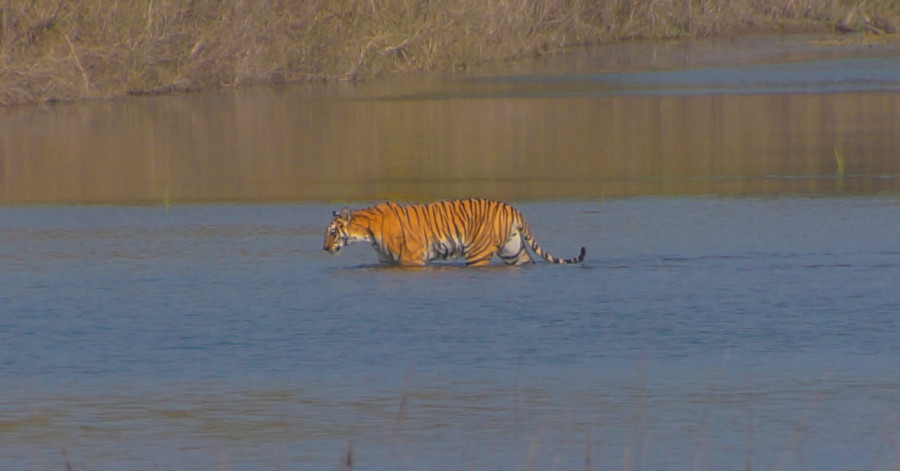Columns
When it comes to tiger population, the figures must be treated with caution
An increase in tiger count is implausible when a report reveals their natural habitat is declining.
Chandramani Aryal
The doubling of the tiger population in less than nine years in Nepal has raised hopes for the survival of this endangered species. While global conservation efforts in recent years mean that tiger numbers are on the rise, they are certainly not out of the woods yet. But more importantly, the figures need to be treated with caution.
The 20th century observed an unprecedented decline in the population and habitat of the tiger. If there were 100,000 wild tigers roaming in their natural habitat at the beginning of the 20th century, by the end of it, the number had reduced to as low as 3,200 alarming conservationists across regions. Hence, conservation efforts increased the world over. What's more, in the same time frame, the habitat of the tiger was reduced by seven percent.
This seven percent includes potential habitats such as the Koshi-Triyuga complex of eastern Nepal, from where the endangered big cat is believed to have been extinct before the beginning of the 21st century.
Tiger Ecology Project was initiated in Nepal as a joint venture of the Nepal government and Smithsonian Institute, USA in the 1970s. Over time, different parks including the recently established Banke National Park were primarily established with the motive of conserving tigers and their habitats. Besides the establishment of a protected area network, Nepal has been planning landscape-level conservation targeting the tiger range. The Tarai Arc Landscape (TAL)— encompassing the area of 51,002 sq km and connecting 14 parks of India and Nepal—was established in 2003. The main objectives of TAL are to restore the corridor for the movement of tiger and elephants and to connect the conservation with community livelihood. Increase in the number of tigers from 198 (in 2013) to 235 (in 2017) indicate the success of conservation programmes.
Though the numbers are encouraging, they need to be treated with caution. The Department of National Parks and Wildlife Conservation (DNPWC), Department of Forests (DoF), National Trust for Nature Conservation (NTNC), World Wildlife Fund Nepal (WWF) and Zoological Society of London-Nepal office (ZSL-Nepal) have been at the forefront of tiger conservation efforts in Nepal. These five giants are involved in the formulation of a conservation plan, allocation of funding for conservation and monitoring the success of the intervention made (i.e. Tiger census). There is no practice of peer review of the reports generated.
Talking about anomalies, despite the completion of the 2017 tiger census, the report was not published on time. The data regarding the number of tigers was let out in late September of the same year a comprehensive was not published until the beginning of 2019. The delay in the dissemination of the report was primarily attributed to the decline in the number of tigers in the Chitwan National Park. This discrepancy in the initially claimed number and the actual number makes one treat the figures with caution.
As a stable population usually has an upright pyramid shape, low capture of juveniles and cubs (28 compared to 209 mature ones) might indicate the criticality of conservation intervention. Normally, the home range of a male tiger overlaps with that of 3-5 female i.e. female tiger population exceeds by 3 to 5 times of their male counterparts. But in the 2017 census, the population of an adult male was 78 while that of an adult female was 118.
This indicates that one male tiger accounts for 1.51 female—a drastic change in the figure from the earlier census conducted in 2013 where one male tiger accounted for 2.55 female tigers. In the same year, the number of male tigers stood at 40 while that of the female tiger was 105.
Tiger cubs normally stay for nearly two years with their mother. Meaning, the female tigers won’t generally produce next batch of cubs till two to two and a half years. Given this scenario, a great change in the male-female ratio and rise in tiger individuals in Bardia (87 from 50) and Banke National Park (21 from 4 individuals) between 2013 and 2017 seems implausible.
The range of distribution is also reported to change between 2013 and 2017. In 2013, tiger signs were recorded from Rupendehi, Kapilvastu and Rautahat district but in the latest survey, no signs were recorded. Tiger survey report also indicates that prey base is declining in protected areas of Nepal from where tigers are reported. Increase in the number of tiger individuals while both the habitat and prey base are declining is ironical. Anyone with a little knowledge of geography can realise the facts that prey base survey are carried out in grasslands and riverine foothills of Chure and are extrapolated to the Chure hills which hold low prey base.
The problems of tiger conservation are not merely biological ones; there are social dimensions as well. With the increase in the number of tigers, leopards are forced to find alternative settlements. As forests shrink owing to increased human settlements, tigers are forced to search alternative territories. This has become a major issue and will pose severe challenges to tiger conservation.
Reliable quantification of the species is important to pursue sincere conservation efforts. The reliability of information can be enhanced through holistic participation of experts in the planning, implementation and monitoring process of conservation intervention.




 12.12°C Kathmandu
12.12°C Kathmandu















